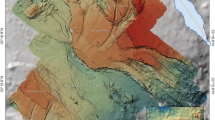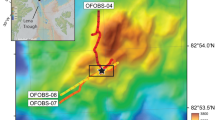Abstract
Evidence is growing that hydrothermal venting occurs not only along mid-ocean ridges but also on old regions of the oceanic crust away from spreading centres. Here we report the discovery of an extensive hydrothermal field at 30° N near the eastern intersection of the Mid-Atlantic Ridge and the Atlantis fracture zone. The vent field—named ‘Lost City’—is distinctly different from all other known sea-floor hydrothermal fields in that it is located on 1.5-Myr-old crust, nearly 15 km from the spreading axis, and may be driven by the heat of exothermic serpentinization reactions between sea water and mantle rocks. It is located on a dome-like massif and is dominated by steep-sided carbonate chimneys, rather than the sulphide structures typical of ‘black smoker’ hydrothermal fields. We found that vent fluids are relatively cool (40–75 °C) and alkaline (pH 9.0–9.8), supporting dense microbial communities that include anaerobic thermophiles. Because the geological characteristics of the Atlantis massif are similar to numerous areas of old crust along the Mid-Atlantic, Indian and Arctic ridges, these results indicate that a much larger portion of the oceanic crust may support hydrothermal activity and microbial life than previously thought.
This is a preview of subscription content, access via your institution
Access options
Subscribe to this journal
Receive 51 print issues and online access
$199.00 per year
only $3.90 per issue
Buy this article
- Purchase on Springer Link
- Instant access to full article PDF
Prices may be subject to local taxes which are calculated during checkout


Similar content being viewed by others
References
Fornari, D. J. & Embley, R. W. in Seafloor Hydrothermal Systems, Physical, Chemical, Biological, and Geological Interactions (eds Humphris, S. E., Zierenberg, R. A., Mullineaux, S. & Thomson, R. E.) 1–26 (American Geophysical Union Monograph 91, Washington DC, 1995).
Hannington, M. D., Jonasson, I. R., Herzig, P. M. & Petersen, S. in Seafloor Hydrothermal Systems, Physical, Chemical, Biological, and Geological Interactions (eds Humphris, S. E., Zierenberg, R. A., Mullineaux, S. & Thomson, R. E.) 115–157 (American Geophysical Union Monograph 91, Washington DC, 1995).
Tivey, M K., Stakes, D. S., Cook, T. L., Hannington, M. D. & Petersen, S. A model for growth of steep-sided vent structures on the Endeavour Segment of the Juan de Fuca Ridge: Results of a petrologic and geochemical study. J. Geophys. Res. 104, 22859–2283 (1999).
German, C. R., Parson, L. M. & HEAT Scientific Team. Hydrothermal exploration near the Azores Triple Junction: tectonic control of venting at slow-spreading ridges? Earth Planet. Sci. Lett. 138, 93–104 (1996).
Gracia, E., Charlou, J. C., Radford-Knoery, J. & Parson, L. M. Non-transform offsets along the Mid-Atlantic Ridge south of the Azores (38° N–34° N): ultramafic exposures and hosting of hydrothermal vents. Earth Planet. Sci. Lett. 177, 89–103 (2000).
Barriga, F. J. A. S. et al. Discovery of the Saldanha Hydrothermal field on the FAMOUS Segment of the MAR (36° 30′ N). Eos 79, 67 (1998).
Cann, J. R. et al. Corrugated slip surfaces formed at ridge-transform intersections on the Mid-Atlantic Ridge. Nature 385, 329–332 (1997).
Blackman, D. K., Cann, J. R., Janesen, B. & Smith, D. K. Origin of extensional core complexes: Evidence from the Mid-Atlantic Ridge at Atlantis Fracture Zone. J. Geophys. Res. 103, 21315–21333 (1998).
Coleman, R. G. Petrologic and geophysical nature of serpentinites. Geol. Soc. Am. Bull. 82, 897–918 (1971).
Barnes, I., Rapp, J. R., O'Neil, J. R., Sheppard, R. A. & Gude, A. J. Metamorphic assemblages and the direction of flow of metamorphic fluids in four instances of serpentinization. Contrib. Mineral. Petrol. 35, 263–276 (1972).
Fryer, P. et al. Conical Seamount: SeamarcII, ALVIN submersible and seismic reflection studies. Proc. ODP Init. Rep. 125, 69–94 (1990).
Haggerty, J. A. in Seamounts, Islands, and Atolls (eds Keating, B., Fryer, P. & Batiza, R.) 175–185 (American Geophysical Monograph Series 47, Washington DC, 1987).
Bonatti, E., Lawrence, J. R., Hamlyn, P. R. & Breger, D. Aragonite from deep sea ultramafic rocks. Geochim. Cosmochim. Acta 44, 1207–1214 (1980).
Früh-Green, G. L., Plas, A. & Lecuyer, C. Petrologic and stable isotope constraints on hydrothermal alteration and serpentinization of the EPR shallow mantle at Hess Deep (Site 895). Proc. ODP Sci. Res. 147, 255–291 (1996).
Sakai, R., Kusakabe, M., Noto, M. & Ishii, T. Origin of waters responsible for serpentinization of the Izu-Ogasawara-Mariana forearc seamounts in view of hydrogen and oxygen isotope ratios. Earth Planet. Sci. Lett. 100, 291–303 (1990).
Janecky, D. R. & Seyfried, W. E. Jr Hydrothermal serpentinization of peridotite within the oceanic crust: Experimental investigations of mineralogy and major element chemistry. Geochim. Consmochim. Acta 50, 1357–1378 (1986).
Wetzel, L. R. & Shock, E. L. Distinguishing ultramafic from basalt-hosted submarine hydrothermal systems by comparing calculated vent fluid compositions. J. Geophys. Res. 105, 8319–8340 (2000).
Van Dover, C. L. in The Ecology of Deep-Sea Hydrothermal Vents 63–69 (Princeton Univ. Press, Princeton, New Jersey, 2000).
Donval, J. P. et al. High H2 and CH4 content in hydrothermal fluids from Rainbow site newly sampled at 36° 14′ N on the AMAR segment, Mid-Atlantic Ridge (diving FLORES cruise, July 1997). Comparison with other MAR sites. Eos 78, 832 (1997).
Charlou, J. L. et al. Compared geochemical signatures and the evolution of Menez Gwen (37° 50′ N) and Lucky Strike (37° 17′ N) hydrothermal fluids, south of the Azores Triple Junction on the Mid-Atlantic Ridge. Chem. Geol. 171, 49–75 (2000).
Krasnov, S. G. et al. in Hydrothermal Vents and Processes (eds Parson, L. M., Walker, C. L. & Dixon, D. R.) 43–64 (Geological Society Special Publication 87, London, 1995).
Douville, E., Charlou, J. L., Donval, J. P., Knoery, J. & Fouquet, Y. Trace elements in fluids from the new Rainbow hydrothermal field (36° 14′ N, MAR): a comparison with other Mid-Atlantic Ridge fluids. Eos 78, 832 (1997).
Fouquet, Y. Geological setting and compositions of hydrothermal sulfide deposits along the Mid-Atlantic Ridge. Volcanic control versus tectonic control of sulfide mineralization. Eos 78, 832 (1977).
Lagabrielle, Y. D., Bideau, D., Cannat, M., Karson, J. A. & Mevel, C. in Faulting and Magmatism at Mid-Ocean Ridges (eds Buck, W. R., Delaney, P. T., Karson, J. A. & Lagabrielle, Y.) 153–176 (American Geophysical Union Monograph 106, Washington, DC, 1998).
Shock, E. L. & Schulte, M. D. Organic synthesis during fluid mixing in hydrothermal systems. J. Geophys. Res. 103, 28513–28527 (1998).
Allen, D. A., Berndt, M. E., Seyfried, W. E. Jr & Horita, J. Inorganic reduction of CO2 to HCOOH, CH4, and other reduced carbon compounds with application to subseafloor hydrothermal systems. Eos 79, 58–59 (1998).
Berndt, M. E., Allen, D. E. & Seyfried, W. E. Jr Reduction of CO2 during serpentinization of olivine at 300 °C and 500 bar. Geology 24, 351–354 (1996).
Janecky, D. R. & Seyfried, W. E. Jr Hydrothermal serpentinization of peridotite within the oceanic crust: Experimental investigations of mineralogy and major element chemistry. Geochim. Cosmochim. Acta 50, 1357–1378 (1986).
Neal, C. & Stanger, G. Hydrogen generation from mantle source rocks in Oman. Earth Planet. Sci. Lett. 66, 315–320 (1983).
Karson, J. A. & Lawrence, R. M. Tectonic setting of serpentinite exposures on the western median valley wall of the MARK area in the vicinity of Site 920. Proc. ODP Sci. Res. 153, 5–21 (1997).
Rona, P. A. et al. Hydrothermal circulation, serpentinization and degassing at a rift-valley fracture zone intersection: Mid-Atlantic Ridge near 15° N, 45° W. Geology 20, 783–786 (1992).
Charlou, J. L. et al. Intense CH4 degassing generated by serpentinization of ultramafic rocks at the intersection of the 15° 20′ N fracture zone and the Mid-Atlantic Ridge. Geochim. Cosmochim. Acta 62, 2323–2333 (1998).
Bougault, H. et al. FAMOUS and AMAR segments on the Mid-Atlantic Ridge: ubiquitous hydrothermal Mn, CH4, δ3He signals along the rift valley walls and rift offsets. Earth Planet. Sci. Lett. 161, 1–17 (1998).
Schopf, J. W. Earth's Earliest Biosphere: Its Origin and Evolution (ed. Schopf, J. W.) 1–543 (Princeton Univ. Press, New Jersey, 1983).
Russell, M. J. & Hall, J. A. The emergence of life from iron monosulfide bubbles at a submarine hydrothermal redox and pH front. J. Geol. Soc. Lond. 153, 1–26 (1996).
MacLeod, G., McKeown, C., Hall, H. J. & Russell, M. J. Hydrothermal and oceanic pH conditions of possible relevance to the origin of life. Orig. Life Evol. Biosph. 23, 19–41 (1994).
Pace, N. R. A molecular view of microbial diversity and the biosphere. Science 276, 734–740 (1997).
James, R. H., Elderfield, H. & Palmer, M. R. The chemistry of hydrothermal fluids from the Broken Spur site, 29° N Mid-Atlantic Ridge. Geochim. Cosmochim. Acta 59, 651–659 (1995).
Butterfield, D. A. et al. Gradients in the composition of hydrothermal fluids from Endeavour Ridge vent field: Phase separation and brine loss. J. Geophys. Res. 99, 9561–9583 (1994).
Lilley, M. D. et al. Anomalous CH4 and NH+4 concentrations at an unsedimented mid-ocean ridge hydrothermal system. Nature 364, 45–47 (1993).
Von Damm, K. L. in Seafloor Hydrothermal Systems: Physical, Chemical, Biological, and Geological Interactions (eds Humphris, S. E., Zierenberg, R. A., Mullineaux, S. & Thomson, R. E.) 222–247 (American Geophysical Union Geophysical Monograph 91, Washington DC, 1995).
Neal, C. & Stanger, G. Calcium and magnesium hydroxide precipitation from alkaline groundwaters in Oman, and their significance to the process of serpentinization. Mineral. Mag. 48, 237–241 (1984).
Seewald, J. S. & Seyfried, W. E. Jr The effect of temperature on metal mobility in subseafloor hydrothermal systems: Constraints from basalt alteration experiments. Earth Planet. Sci. Lett. 101, 388–403 (1990).
Acknowledgements
Shipboard party participants on cruise AT03-60 include N. Bacher, M. Basgall, D. K. Blackman, J. Cann, G. L. Frith-Green, J. S. Gee, H. Hanna, S. D. Hurst, B. E. John, J. A. Karson, D. S. Kelley, S. Lyons, J. Morgan, S. Nooner, P. Rivizzigno, D. K. Ross, G. Sasagawa and T. Schroeder. We thank the pilots, officers and crew of the RV Atlantis-Alvin for their professional service during this cruise. We are also grateful to the operators of ArgoII for their expert navigation of the camera system during the discovery exploration dive to this field. We also thank P. Hickey for piloting of Alvin, his sampling and his observation during the submersible dive. Support for this program was provided by the National Science Foundation.
Author information
Authors and Affiliations
Consortia
Corresponding author
Rights and permissions
About this article
Cite this article
Kelley, D., Karson, J., Blackman, D. et al. An off-axis hydrothermal vent field near the Mid-Atlantic Ridge at 30° N. Nature 412, 145–149 (2001). https://doi.org/10.1038/35084000
Received:
Accepted:
Issue Date:
DOI: https://doi.org/10.1038/35084000
This article is cited by
-
Fluid chemistry alters faunal trophodynamics but not composition on the deep-sea Capelinhos hydrothermal edifice (Lucky Strike vent field, Mid-Atlantic Ridge)
Scientific Reports (2024)
-
Generation of long-chain fatty acids by hydrogen-driven bicarbonate reduction in ancient alkaline hydrothermal vents
Communications Earth & Environment (2024)
-
The influence of silica on reaction rates and molecular hydrogen (H2) generation during olivine hydrothermal alteration
Science China Earth Sciences (2024)
-
Quaternary low-temperature serpentinization and carbonation in the New Caledonia ophiolite
Scientific Reports (2023)
-
The rocky road to organics needs drying
Nature Communications (2023)
Comments
By submitting a comment you agree to abide by our Terms and Community Guidelines. If you find something abusive or that does not comply with our terms or guidelines please flag it as inappropriate.



